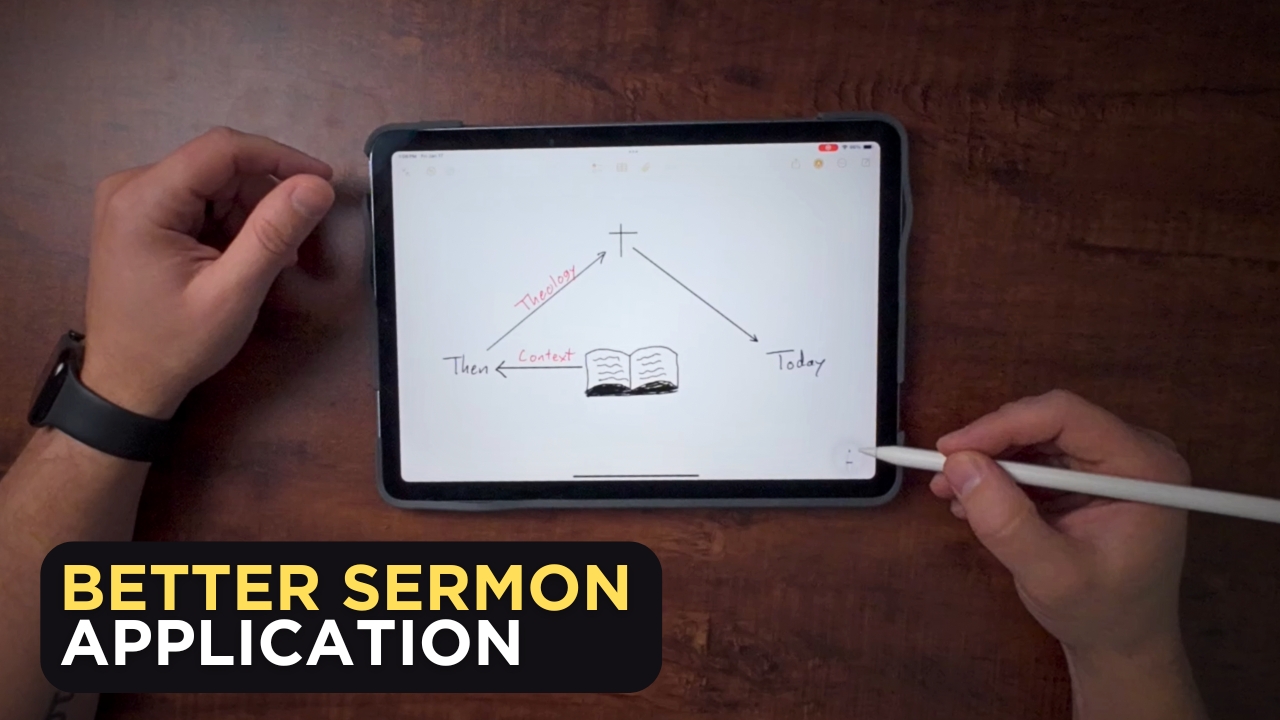3 Steps For Better Sermon Application

Have you ever struggled with sermon application? One of the most dangerous, most abused, and most frustrating parts of preaching a sermon is the application section.
Any decent preacher will open the Bible and read a verse—hopefully more than just one. Then, they will tell the audience what this means for them. After reading this verse, how then should we live? How does this apply today?
And this is the testing ground for either heresy, spiritual abuse, legalism, or even well-intentioned bad preaching.
In 2 Timothy 2:15, Paul writes, “Do your best to present yourself to God as one approved, a worker who has no need to be ashamed, rightly handling the word of truth.”
The Word of God is like a sword. In the right hands, it is a masterful tool. In the wrong hands, it is dangerous!
So how do we rightly handle the word of truth? A while back, I learned a three step process that will help you to apply any passage of Scripture properly.
It’s a simple concept, but I wish more pastors, preachers, and Bible teachers would do this. It would save us from so much of the junk that pastors preach today.
STEP 1: THEN (Context)
The problem I see most is that most people start with a verse in the Bible and then immediately jump to application—what does this mean today? You take a 21st century as view of a 1st century or far older text!
So before you jump ahead, we need to look back at the historical, grammatical, and literary context. What did the original author say, and how was it understood by the original audience back then?
We cannot apply a passage until we know its original intent. When we don’t understand the context of a passage, we can take verses like Jeremiah 29:11, “For I know the plans I have for you, declares the LORD, plans for welfare and not for evil, to give you a future and a hope.” and claim it as a promise that our life will get better.
The only problem is that nobody knows Jeremiah 29:10. The context of the passage is that God is allowing the Israelite people to be conquered and taken away into exile in Babylon, and they will be there for 70 years until God allows them to return to their home.
Many of the people will die in exile. Not all of them will return. Yes, God is faithful. Yes, God has a plan. But it doesn’t mean that you will not suffer consequences for your sins. It doesn’t mean that you will not go through difficult seasons in life, and for some of us, our whole life may be a hardship.
God never promises that life will be easy, but he does promise that he will be faithful to his people.
We have to understand the context! Once we do that, then we can go to the next step.
STEP 2: CHRIST (Theology)
If we understand the context, we are tempted to then jump forward to the application. But that can trip you up as well.
We also need to interpret the Bible by what we read in the rest of the Bible. These books were not written in isolation. Why did God give us 66 books? Why not just one book? He wants us to search and to know the Scriptures because we gain clarity and understanding by knowing what all of the Bible says instead of only taking one verse in isolation.
For example, we could read the sixth commandment, “You shall not murder.” (Exod 20:13), and think, “That means that I should not murder anyone today.” That’s partially true. But we would miss the greater theological understanding where Jesus said that if we even have hatred for someone in our heart, we are guilty of breaking this command (Mt 5:22). It’s more than just the letter of the law, but also the heart behind it.
So we have to understand the biblical and theological context. How do we understand this passage through the work of Christ and all we know about what the Bible teaches? How does the Gospel shape influence how we understand this now? Through Christ.
How does it point forward or back to the Gospel? And how does that shape our understanding of the passage?
Jesus told us that he is the key to understanding the Bible.
In Matthew 5:17, Jesus says, “Do not think that I have come to abolish the Law or the Prophets; I have not come to abolish them but to fulfill them.”
We don’t throw out the Old Testament, but we understand it differently today on this side of redemptive history because Christ fulfilled the law and the prophecies of his coming.
On the road to Emmaus, Jesus appeared to two of the disciples and explained how Scripture pointed to himself. Then, he appeared to all the disciples and said this:
“44 Then he said to them, “These are my words that I spoke to you while I was still with you, that everything written about me in the Law of Moses and the Prophets and the Psalms must be fulfilled.” 45 Then he opened their minds to understand the Scriptures, 46 and said to them, “Thus it is written, that the Christ should suffer and on the third day rise from the dead, 47 and that repentance for the forgiveness of sins should be proclaimed in his name to all nations, beginning from Jerusalem” (Luke 24:44-47)
Jesus is the key to unlocking your understanding of the Bible. The Law and the Prophets point forward to his coming. And all of the New Testament either points back to Christ or forward to his return. We cannot interpret a passage without thinking about the broader context of what the entire Bible teaches.
After we look at the whole scope of the Bible, what the theological context of this verse is in light of what we know about all of Scripture and the good news of Christ, then we are finally ready to apply it.
TODAY (Application)
This is the part that everyone wants to get to, and we are finally here. Now we can ask: “In light of the context of this passage and the broader context of all related teaching in the Bible, How does it now apply to our specific situation today?
Jesus gives us a simple way to understand this in Mark 12:28-31. He is asked, “Which commandment is the most important of all?” 29 Jesus answered, “The most important is, ‘Hear, O Israel: The Lord our God, the Lord is one. 30 And you shall love the Lord your God with all your heart and with all your soul and with all your mind and with all your strength.’ 31 The second is this: ‘You shall love your neighbor as yourself.’ There is no other commandment greater than these.”
All the Bible is summarized in loving God and loving our neighbors. So all application of Scripture fits into these categories. In light of the context of this passage and what God has revealed throughout Scripture, how does this apply today in the way that we love God and others?
Think of a grid of people in your audience: mothers, fathers, daughters, sons, workplace, school, etc. How might this apply to your people?
Sermon Application Examples:
Let’s look at a few more examples of how this works.
A SIMPLE EXAMPLE: Sacrificial laws – context meant sacrifice a sheep. Through Christ, he is the perfect sheep. Today, have faith in Christ our perfect sacrifice and receive the grace he has give you.
A HARDER EXAMPLE: Godly Jealousy – I recently preached a sermon on Numbers 25:1-13. Phinehas is jealous for God and kills two people in the camp a man and a foreign woman because they broke God’s command not to intermarry with other nations who would turn their hearts from God (while all the people are repenting because of a plague God sent their way). And God approves of Phinehas, commending him for being jealous for the Lord! What? How do we apply this? Should I go run sinners through with a spear?
Let’s run it through this application process.
Then: The context is that Phinehas kills man who took gentile wife. He has a godly jealousy and zeal to defend God’s holiness. God says it is good.
Christ: Why don’t we kill anyone who marries an unbelieving wife today? Or who disobeys God today? Jesus took the spear for us. He took the punishment that we deserve.
Today: Have a godly jealousy—a righteous zeal for the Lord. Live passionate, holy lives pursuing what pleases God, knowing that you are forgiven because, by God’s grace, Jesus took the spear that you and I deserve.
So next time you are preaching, before jumping to application, consider using this method. Start with scripture. And ask, “What did it mean then?” Then ask, “How does looking through the lens of Christ affect our understanding of this?” And finally, with this understanding, “How does it apply to us today?”
Try it, and let me know how it goes. You’ll have a much richer, Christ-centered sermon application.


You should never finish a sermon without a good application.